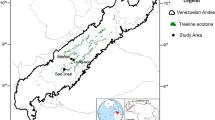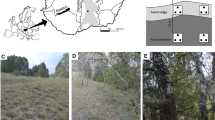Abstract
The importance of seedling establishment to the position ofalpine-treeline is recognized, yet little is known about factorsaffecting the survival of seedlings of treeline conifers during their initialyears of growth and establishment. This establishment period may have thegreatest mortality of all life stages until death of mature trees by disease orfire. Spatial and temporal patterns in the distribution and survival ofseedlings of Picea engelmannii and Abieslasiocarpa were evaluated over four years in analpine-treeline ecotone of the Snowy Range, Wyoming, USA. Seedlings andsaplings of both species occurred most frequently near islands of adult trees.For P. englemannii, this appeared partly due to decreasedsurvivorship of young seedlings (< 5 cm height) with greaterdistance away from tree islands. Survival of emergents of P.engelmannii was 28% greater on the north compared to southsides of tree islands, 48% lower on south-facing slopes comparedto other aspects, and 70% greater with overhead cover such as treebranches. Survival of emergents was greater in microsites with grass cover(90% survival) compared to without ground cover (44% survival),but lowest in microsites surrounded, but not covered, by grass (19%).From 1994–1999, natural seedling emergence and survival washighest in 1995 (80% survival of 221 P.engelmannii,and 100% of seven A. lasiocarpa, in a sample areaof432 m2), when the smallest mean difference in dailymaximum and minimum temperatures occurred, and lowest in 1994 (30% ofseven P. engelmannii), when above-averagetemperatures were accompanied by low rainfall and clear skies. The growthseasons of 1994 and 1995 had among the lowest and highest precipitation of theprevious 30-year period, respectively. In an artificial seedingexperiment, less than 20% of seedlings of both species survived theirfirst complete year of growth. In the autumn of the second year, almost25% additional mortality was observed in the remaining experimentalseedlings when they were exposed to clear, cold skies without the normalprotection of snowcover. Both spatial and temporal patterns of seedlingsurvivalsuggest that exposure to high sunlight may exacerbate low-temperatureandwater stress in young conifer seedlings, inhibiting their establishment in thisalpine treeline.
Similar content being viewed by others
References
Anderson L.J. and Winterton A.J. 1996. Germination as a determinant of seedling distributions among natural substrates in Picea engelmannii (Pinaceae) and Abies lasiocarpa (Pinaceae). American Journal of Botany 83: 112–117.
Ball M.C., Hodges V.S. and Laughlin G.P. 1991. Cold-induced photoinhibition limits regeneration of snow gum at treeline. Functional Ecology 5: 663–668.
Ball M.C., Egerton J.J.G., Leuning R., Cunningham R.B. and Dunne P. 1997. Microclimate above grass adversely affects spring growth of seedling snow gum. Plant, Cell, and Environment 20: 155–166.
Bazzaz F.A. 1979. The physiological ecology of plant succession. Annual Review of Ecology and Systematics 10: 351–371.
Bertness M.D. and Callaway R.M. 1994. Positive interactions in communities. Trends in Ecology and Evolution 9: 191–193.
Billings W.D. 1959. An alpine snowbank environment and its effects on vegetation, plant development, and productivity. Ecology 40: 388–397.
Billings W.D. 1969. Vegetational pattern near alpine timberline as affected by fire snowdrift interactions. Vegetatio 19: 192–207.
Bristow K.L. and Campbell G.S. 1984. On the relationship between incoming solar radiation and daily maximum and minimum temperature. Agricultural and Forest Meteorology 31: 159–166.
Callaway R.M. and Walker L.R. 1997. Competition and facilitation: A synthetic approach to interactions in plant communities. Ecology 78: 1958–1965.
Campbell G.S. and Norman J.M. 1997. An Introduction to Environmental Biophysics. 2nd edn. Springer, New York.
Cornic G. 1994. Drought stress and high light effects on leaf photosynthesis. In: Baker N.R. and Bowyer J.R. (eds), Photoinhibition of Photosynthesis: From Molecular Mechanisms to the Field. Bios Scientific, Oxford, pp. 297–313.
Cui M. and Smith W.K. 1991. Photosynthesis, water relations, and mortality in Abies lasiocarpa seedlings during natural establishment. Tree Physiology 8: 37–46.
Daly C. and Shankman D. 1985. Seedling establishment by conifers above tree limit on Niwot Ridge, Front Range, Colorado, USA. Arctic and Alpine Research 17: 389–400.
Egerton J.J.C., Banks J.C.G., Gibson A., Cunningham R.B. and Ball M.C. 2000. Facilitation of seedling establishment: Reductions in irradiance enhances winter growth of Eucalyptus pauciflora. Ecology 81: 1437–1449.
Ferrar P.J., Cochrane P.M. and Slatyer R.O. 1988. Factors influencing germination and establishment of Eucalyptus pauciflora near the alpine treeline. Tree Physiology 17: 27–43.
Geiger R. 1965. The Climate Near Ground. Harvard University Press, Cambridge.
Germino M.J. and Smith W.K. 1999. Sky exposure, crown architecture, and low-temperature photoinhibition in conifer seedlings at alpine treeline. Plant, Cell, and Environment 22: 407–415.
Germino M.J. and Smith W.K. 2000a. Differences in microsite, plant form, and low-temperature photoinhibition in alpine plants. Arctic, Antarctic, and Alpine Research 32: 388–396.
Germino M.J. and Smith W.K. Relative importance of microhabitat, plant form, and photosynthetic physiology to carbon gain in two alpine herbs. Functional Ecology (in press).
Graumlich L.J. 1994. Long-term vegetation change in mountain environments: paleoecological insights into modern vegetation dynamics. In: Beniston M. (ed.), Mountain Environments in Changing Climates. Routledge, London, pp. 167–179.
Harper J.L. 1977. The Population Biology of Plants. Academic Press, New York.
Hättenschwiler S. and Smith W.K. 1999. Seedling occurrence in alpine treeline conifers: A case study from the central Rocky Mountains, USA. Acta Oecologia 20: 219–224.
Hessl A.E. and Baker W.L. 1997. Spruce and fir regeneration and climate in the forest-tundra ecotone of Rocky Mountain National Park, Colorado, USA. Arctic and Alpine Research 29: 173–183.
Holmgren M., Scheffer M. and Huston M.A. 1997. The interplay of facilitation and competition in plant communities. Ecology 7: 1966–1975.
Jordan D.N. and Smith W.K. 1995. Microclimate factors influencing the frequency and duration of growth season frost for sub-alpine plants. Agricultural and Forest Meteorology 77: 17–30.
Kearney M.S. 1981. Recent seedling establishment at timberline in Jasper National Park, Alta. Canadian Journal of Botany 64: 2283–2287.
Knapp A.K. and Smith W.K. 1982. Factors influencing understory seedling establishment of Engelmann spruce (Picea engelmannii) and subalpine fir (Abies lasiocarpa). Canadian Journal of Botany 60: 2753–2761.
Knight D.H. 1994. Mountains and Plains: The Ecology of Wyoming Landscapes. Yale University Press.
Körner Ch. 1998. A reassessment of high elevation treeline positions and their explanation. Oecologia 115: 445–459.
Leuning R. and Cremer K.W. 1988. Leaf temperatures during radiation frost. Part I. Observations. Agricultural and Forest Meteorology 42: 121–133.
Lloyd A.H. and Graumlich L.J. 1997. Holocene dynamics of treeline forests in the Sierra Nevada. Ecology 78: 1199–1210.
Long S.P., Humphries S., and Falkowski P.G. 1994. Photoinhibition of Photosynthesis in nature. Annual Review of Physiology and Plant Molecular Biology 45: 633–662.
Moir W.H., Rochelle S.G. and Schoettle A.W. 1999. Microscale patterns of tree establishment near upper treeline, Snowy Range, Wyoming, USA. Arctic, Antarctic, and Alpine Research 31: 379–388.
Musselman R.C. 1994. The Glacier Lakes Ecosystem Experiments Site. USDA Forest Service General Technical Report, RM-249.
Oosting H.J. and Reed J.F. 1952. Virgin spruce-fir of the Medicine Bow Mountains, Wyoming. Ecological Monographs 22: 69–91.
Öquist G., Greer D.H. and Ögren E. 1987. Light stress at low temperature. In: Kyle D.J., Osmond C.B. and Arntzen C.J. (eds), Photoinhibition. Elsevier, Amsterdam, pp. 67–87.
Patten D.T. 1963. Light and temperature influence on Engelmann Spruce seed germination and subalpine forest advance. Ecology 44: 817–818.
Rochefort R.M., Little R.L., Woodward A. and Peterson D.L. 1994. Changes in sub-alpine tree distribution in western North America: a review of climatic and other causal factors. The Holocene 4: 89–100.
Ronco F. 1970. Influence of high light intensity on survival of planted Engelmann spruce. Forest Science 16: 331–339.
Shea L.S. and Grant M.C. 1985. Clonal growth in spire-shaped Engelmann spruce and subalpine fir trees. Canadian Journal of Botany 66: 255–261.
Slatyer R.O. and Noble I.R. 1992. Dynamics of montane treelines. In: Hansen A.J. and di Castri F. (eds), Landscape Boundaries: Consequences for Biotic Diversity and Ecological Flows. Springer-Verlag, New York, pp. 346–359.
Smith W.K. and Knapp A. 1990. Ecophysiology of high elevation forests. In: Osmond C.B., Pitelka L.F. and Hidy G.M. (eds), Plant Biology of the Basin and Range. Springer-Verlag, New York, pp. 87–142.
Stevens G.C. and Fox J.F. 1991. The causes of treeline. Annual Review of Ecology and Systematics 22: 177–191.
Tranquillini W. 1979. Physiological Ecology of the Alpine Timberline. Springer-Verlag, Berlin.
Valladares F. and Pearcy R.W. 1997. Interactions between water stress, sun-shade acclimation, heat tolerance, and photoinhibition in the sclerophyll Heteromeles arbutifolia. Plant, Cell, and Environment 20: 25–36.
Weisberg P.J. and Baker W.L. 1995. Spatial variation in tree regeneration in the forest tundra ecotone, Rocky Mountain National Park, Colorado. Canadian Journal of Forest Resources 25: 1326–1339.
Zar J.H. 1999. Biostatistical Analysis. 2nd edn. Prentice-Hall, New Jersey.
Author information
Authors and Affiliations
Rights and permissions
About this article
Cite this article
Germino, M.J., Smith, W.K. & Resor, A.C. Conifer seedling distribution and survival in an alpine-treeline ecotone. Plant Ecology 162, 157–168 (2002). https://doi.org/10.1023/A:1020385320738
Issue Date:
DOI: https://doi.org/10.1023/A:1020385320738




